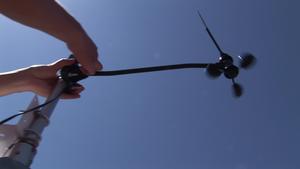A Unique Way to Lower Energy Costs
San Diego, CA, December 5, 2007 -- UC San Diego undergraduate students have designed, built and deployed a network of five weather-monitoring stations as a key step toward helping the university use ocean breezes to cool buildings, identify the sunniest rooftops to expand its solar-electric system, and use water more efficiently in irrigation and in other ways. The network, which will be expanded to 20 stations in 2008, is unprecedented in the United States for the density of weather data to be collected. Project leaders are inviting San Diego-area schools and businesses to make their rooftops available for additional stations to broaden the geographic scope, scientific value, and potential energy savings of the effort.
|
“At home, I am the person who is always shutting off the lights, trying to save energy,” said Mandana Farhadieh, one of the participating students and a bioengineering major. “Getting involved in this project will help me and the university do this on a bigger scale.” Two professors at the Jacobs School of Engineering, Jan Kleissl and Paul Linden, and two from the California Institute for Telecommunications and Information Technology (Calit2), Doug Palmer and Bill Hodgkiss, are mentoring Farhadieh and nine other undergraduate students. Grants from Wells Fargo & Company and campus groups enabled students to install the wireless weather stations on campus rooftops and poles.
Clouds and fog, sunshine hours, temperature and humidity vary considerably from the Scripps Institution of Oceanography on the west side of UCSD’s main campus to sunnier and drier inland areas. UCSD facilities managers plan to use the measurements in real time in a variety of ways. “The campus wants to know how warm and humid it is so they can open or close dampers that take in outside air, a free commodity to cool buildings,” Kleissl said. “There are many applications where detailed weather information can be very useful.”
 |
| UCSD engineering professor Jan Kleissl says the current network of five weather-monitoring stations on campus soon will be expanded to at least 20. |
UCSD and other universities spend a significant portion of their operating budgets to heat and cool buildings. Reducing that consumption by even a small percentage ensures significant long-term savings. With roughly 11 million square feet of space in 300 buildings on the UCSD campus, the weather monitoring stations are expected to yield immediate benefits.
“UC San Diego is a leader when it comes to research in areas like global warming, climate change, and even energy management,” said Steve Relyea, vice chancellor for business affairs, who sees the weather stations as part of a much larger campus effort to use energy efficiently and generate as little waste as possible. “We have a great opportunity on this campus to become a laboratory for those technologies: to put into practice what we’re studying.” UCSD is committed to sustainable operations on a variety of fronts. It offers alternatives to commuting by car, an expanded recycling program and healthier and more energy-efficient lighting. It uses reclaimed water to irrigate landscaping. Employees even single-space printed documents and rely on electronic communications to reduce the use of paper. Facilities managers also have developed a variety of sustainable building, operations and maintenance practices.
Linden has applied his scientific expertise to produce computer models of air flows around downtown San Diego buildings. That model played a key role in the design of the $18 million naturally ventilated Children’s Museum of San Diego, which is under construction at 200 West Island Avenue. The California Energy Commission funded Linden's participation with the museum’s architectural firm, Rob Wellington Quigley, to design an aesthetically pleasing structure that will use half the energy of a conventionally heated and cooled building. A 92-foot-tall elevator tower will vent warm interior air. Most of the gallery and staff spaces will be naturally lit by sunlight, and waterless urinals will help conserve water. The museum’s grand opening is set for May 4, 2008.
 |
| Undergraduate UCSD students designed, built and deployed a network of five weather-monitoring stations on utility poles and building roofs. |
The weather-monitoring instruments, powered by car batteries and textbook-sized photovoltaic panels, are mounted on aluminum tripods. Measurements on building and air temperatures, humidity, rainfall, wind speed and direction, and solar radiation are wirelessly transmitted to a campus computer where it is displayed in near real time at http://maeresearch.ucsd.edu/kleissl/demroes.
“Right now we have five weather stations in operation and we’re trying to cover the whole range from the ocean to East Campus,” Kleissl said. “We will have a very dense network of up to 30 stations on a campus, whereas you usually have one or two stations in an entire city. Weather stations are not new, but the density of the stations is.”
Kleissl and Linden are also planning to expand the weather station network beyond the UCSD campus to middle schools and high schools. “We’re also in contact with businesses and corporations in San Diego who are interested in reducing their costs, being more environmentally friendly, and possibly adding solar-power panels to their rooftops,” Kleissl said.
Related Links
UCSD Weather Monitoring Project Data
UCSD Environment and Sustainability Initiative
Media Contacts
Media Contact: Rex Graham, Jacobs School of Engineering, 858-822-3075, rgraham@soe.ucsd.edu


